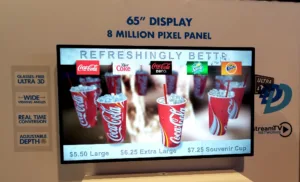Like KDX (KDX Builds Alliance for 3D), Stream TV Networks has been developing glasses-free displays for a long time. These still have the same issues as KDX displays – limited depth volume and accommodation-vergence mismatch and the lack of a full 6 degree-of-freedom navigation, but they do offer some look around capabilities because of the multi-views offered via horizontal parallax.
However, Stream TV’s optical layer is different and has now advanced to the point where they claim there are no viewing zones, just a continuous 3D image in a 140º viewing cone. They are not quite there yet as you can see some distortions as you move horizontally, but they may not be repeating zones, as was done in the past.
In the booth, we saw demos of a 65” glasses-free 3D display with an 8K pixel panel and a 50” version with a UHD resolution panel. I thought the StreamTV images looked a bit better than KDX when using 8K display panels. KDX is using 8K panels from Innolux and Stream TV is using one from BOE. The 65” 8K demo uses a first generation lens design but a second one should be arriving just after CES.
Separately, Stream TV and BOE Technology Group announced a joint cooperation agreement to use BOE panels in glasses-free display made by Stream TV. The agreement covers panels for cell phones, tablet, monitor and TV products.
Mathu Rajan, CEO of Stream TV noted that:
“Working with high-resolution panels from a partner like BOE allows us to gain significant traction in the global market. The human eye can’t tell the difference between 4K and 8K in flat 2D. Without using the third plane, you’re basically throwing away all those pixels. We use those extra pixels for pop and depth to create an immersive experience that brings real value to device makers and their customers.”
In a back room was another demo that Stream TV called an “8K Lite Glasses-Free Ultra-3D display.” They tout this display as having “16M pixels”, whereas a typical RGB stripe 8K panel (7680 x 4320) with have 33M pixels. There is more to this story, but you will have to use your imagination until I can reveal more.
BOE Also Highlighting 8K
BOE was also at the Bellagio showing off the world’s first 75” 8K display with decoding and processor chips developed by HiSilicon. It is a 10-bit panel that achieves 100% of the NTSC color gamut.
BOE has been speeding up in developing 8K industry chain and launched the “8425 strategy” which means “promoting 8K, popularizing 4K, replacing 2K and making good use of 5G”.
Stream TV also announced a new deal with Bravo Media to create dynamic, scalable content solutions for Stream TV’s Ultra-D Glasses-Free 3D displays for reseller partners and direct customers. Bravo Media is an award winning NYC design firm specializing in the creation of content for digital signage, projector mapping, holographic displays, AR and VR experiences and non-traditional platforms including transparent LCDs.
Stream TV also showed a glasses-free 3D 10” tablet based upon a 4K resolution panel and a 27” monitor aimed at gamers. It can support glasses-free 3D playback of content created with Unity or Unreal engines plug-ins, supporting playback with DirectX or OpenGL commands and can even run at 120 Hz. A clip from the 120 fps natively acquired Ang Lee film was shown that looked very good. This should be the first product to get to market in Q3’18 followed by an 8K 65” glasses-free 3D TV. Most likely these will be introduced to the China market at first.
In a white paper published by the company, they showed a schematic of the component of their glasses-free Ultra-D monitor. The Ultra-D optical solution addresses two important depth cues; stereopsis and (partial) motion parallax, resulting in a more natural 3D experience.


